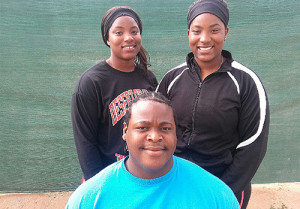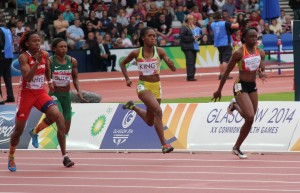 Central Arizona College track and field coach Tony Dougherty paid a visit to the Virgin Islands from 10th-16th July. Coach Dougherty, previously the coach of the women’s programme with responsibility for the college’s throwers of both sexes, took over as head of the combined programme in 2012.
Central Arizona College track and field coach Tony Dougherty paid a visit to the Virgin Islands from 10th-16th July. Coach Dougherty, previously the coach of the women’s programme with responsibility for the college’s throwers of both sexes, took over as head of the combined programme in 2012.
The Central Arizona College connection began in 1994 at the Commonwealth Games in Victoria, British Columbia. Rey O’Neal, then President of the BVI Olympic Committee, in a conversation with Nigerian shot putter Chima Ugwu, inquired about the possibility of athletes training and studying at Central Arizona College where Chima, along with several other Nigerians and a fair number of Jamaicans had helped to make C.A.C a powerhouse among two-year colleges in track and field.
“I was given a contact number for head coach, Kurt Van Hazel, and called him from Canada, although he had probably had little knowledge of our islands or whether we could provide athletes capable of competing at that level, but he was extremely cordial and helpful,” said Mr. O’Neal.
Conversations continued over the following months and in January 1995, Ralston Varlack became the first of our athletes to enrol at Central Arizona. Ralston was a long jump finalist at the National Junior College Championships in 1996 and earned a full athletic scholarship to Wichita State University, where he became Missouri Valley Conference long jump Champion indoors and outdoors and qualified for N.C.A.A Indoor Championships in his event.
The next Virgin Islander at Central Arizona was Steve Augustine, who attended as a recipient of an “Olympic Solidarity Scholarship for Promising young Athletes”. Augustine, arguably the most versatile runner in the history of B.V.I High School track, settled into the hurdles at Central, establishing national records at both the 110 and 400 metre distances. In 1997, he became the first athlete from the Territory to win a gold medal at any national collegiate level. His win in the 400 metre hurdles in1997 was followed by a second place finish the following year. He went on to Florida State University on a full scholarship.
Dion Crabbe, another versatile athlete, had a good if not spectacular tenure at Central Arizona. He was an All-America in the 4×100 metre relay and moved on to Mississippi State University. There he would gain All-America honours in both the 100 and 200 metres and he became the Territory’s first medalist at a multi-sport “Games” when he snatched gold in the short sprint at the Central American and Caribbean Games in 2002. Crabbe never attained the heights of 2002 again but he remained one of the better sprinters in the region until his retirement following the Central American and Caribbean Games in 2006, where he placed sixth in the 100 metres.
Concurrent with Crabbe’s stay at C.A.C was the arrival of Tahirah Lewis, the first female athlete from the Territory to enroll there. She had a decent career at Central Arizona and, though her progress was slowed by illness, set new national records in the shot put and discus throw.
There would be no other Virgin Islands female there until the advent of Karene King and Bianca Dougan in 2007. Like Lewis, who went on to Coppin State University, Dougan and King did well enough to earn scholarships to Portland State University in Oregon and the University of Minnesota respectfully. Dougan had actually become the first female Junior College All-Americaf rom the Virgin Islands as a member of the C.A.C 4X400 metre relay team. King would go on to win the Big Sky Conference 100m-200m sprint double in 2010.
Until 2001 all Virgin Islands athletes at Central Arizona were athletes whose opportunities had been based primarily on perceived potential.That changed with the arrival of 17 year old Eric Matthias, already a Carifta Games and C.A.C Junior Championship gold medalist in the discus throw. He established new National marks in the shot put and discus throw, before moving on to join a strong throws cadre at Boise State University in Idaho, where he would add the Hammer mark to his National Record collection.
Two other young men entered Central Arizona as freshmen during Mathias’ second year – Kevin Fahie, a 400 metre runner, and Ludence Smith, whose best event was the 800 metres. Neither had the athletic pedigree of their compatriot. but each was a member of relay quartet that gained junior college All-America honors in the relays. After graduation, Kevin earned a scholarship to California State University at Northridge while Smith transferred to the University of New Orleans. That decision proved unwise as, in the wake of Hurricane Kathrina, U.N.O. did not field a track team for two years.
The next two years saw the best throwers from the Territory join the C.A.C squads, now led by Coach Al Shirley, with Coach Tony Dougherty having primary responsibility for the throws. Kyle Francis was useful in the Discus throw and shot put, but Omar Jones, twice a C.A.C Junior Championships medalist in the javelin throw really distinguished himself in that event while at Central Arizona. In 2009 he won the National Junior College title, thus becoming the Virgin Islands second National Juco Champion after Steve Augustine’s 1997 success.
A pair of multi-eventers were to find their way to Arizona just after first decade of the 21st century ended. Keron Stoute had established a reputation in Connecticut as one of the top high school multi-eventers on the East Coast. At Central Arizona he earned All-America honours in the decathlon and high jump. He had some difficulty adjusting to the higher hurdles and heavier discus. He finished his collegiate outdoor eligibility at Bethune-Cookman University where he had a good if unspectacular two years.
The heptathlete Kanishque Todman had a strange passage at Central Arizona. After shining in Arizona indoor competitions in 2012 she competed at the National Junior College Championships, finishing a creditable fourth indoors, but never competed collegiately again.

Central Arizona College’s Tynelle Gumbs, left, Trevia Gumbs and Eldred Henry established records in the Weight Throw and Shot Put events respectively. Photo: Tony Dougherty
In 2012 there appeared on the scene on Tortola a giant of a young man who would eclipse Eric Matthias’ records in the shot put and discus throw. A year after beginning to train under the tutelage of Omar Jones, he was making his mark at the regional level with medals in both events at the Carifta Games and top five performances at the Pan American Junior Championships. Granted a full scholarship by coach Tony Dougherty, now heading the combined men’s and women’s track and field programme, Eldred Henry was quick to prove his worth, breaking the national senior records for both implements three times each. He became the first thrower from an O.E.C.S Country to toss the discus beyond 60 metres (and 200 ft). and became the third junior college champion from his country.
Joining Eldred at Central Arizona College in August, 2014 are the Gumbs twins, Trevia and Tynelle, who have six regional Junior Championships medals between them. Trevia is primarily a shot putter, who also throws the discus while Tynelle’s talents lie more with the discus and javelin throws. Both will also be introduced to the hammer throw as well.
The Gumbs sisters are actually the second pair of twins from the Virgin Islands to represent Central Arizona in intercollegiate sports. Basketball players Tamara and Tafara Phillip had played on the 2010-11 and 2011-12 teams. Tamara gained All-Conference honors and earned a scholarship to the University of Albany in New York.
Like his predecessor Kurt Van Hazel, coach Dougherty paid a visit to the Virgin Islands and met several of his past athletes as well as some who might follow the well-worn trail to Coolidge Arizona in the future.

